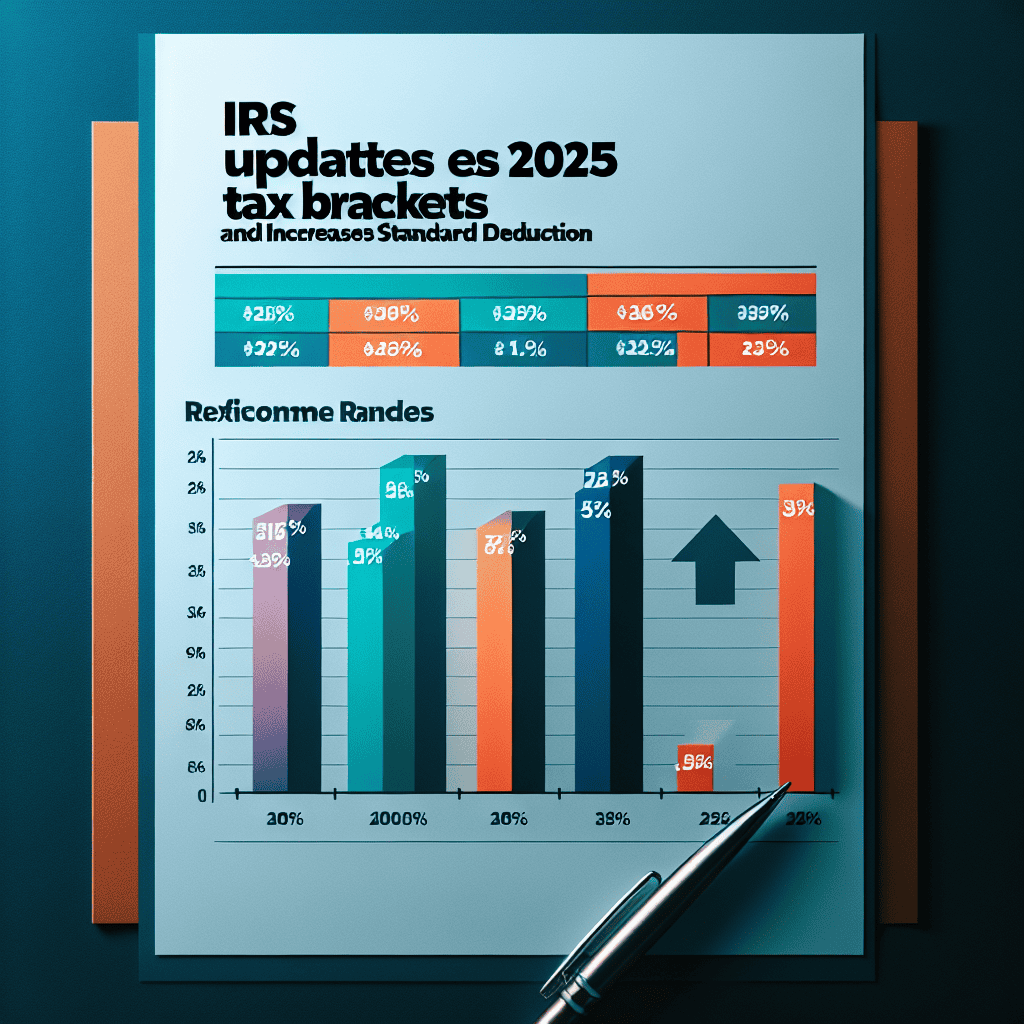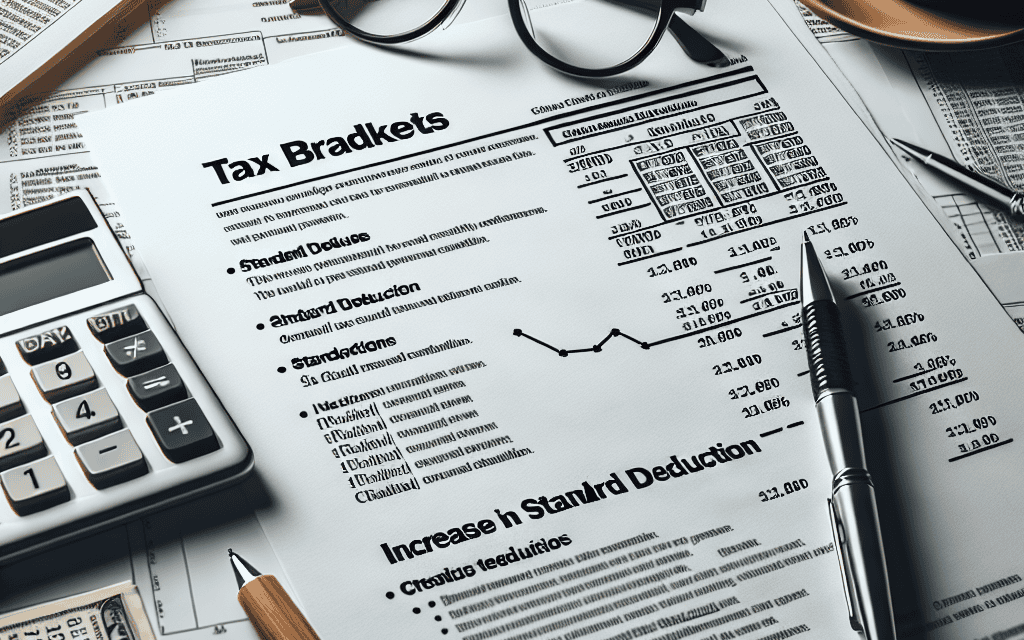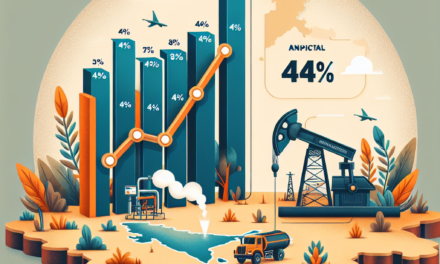“Navigate Your Finances: 2025 Tax Brackets and Standard Deduction Boost Unveiled!”
Introduction
In 2025, the Internal Revenue Service (IRS) has announced updates to the federal tax brackets and an increase in the standard deduction, reflecting adjustments for inflation and changes in tax policy. These updates are crucial for taxpayers as they plan their finances and prepare for the upcoming tax season. The revised tax brackets will impact the marginal tax rates applied to different income levels, potentially affecting the amount of tax owed by individuals and families. Additionally, the increase in the standard deduction aims to simplify the filing process and provide greater tax relief to a broader range of taxpayers. These changes underscore the IRS’s commitment to ensuring that the tax code remains responsive to economic conditions and equitable for all taxpayers.
Understanding the 2025 IRS Tax Bracket Changes
In a significant update for taxpayers, the Internal Revenue Service (IRS) has announced changes to the tax brackets and an increase in the standard deduction for the year 2025. These adjustments are part of the IRS’s annual review process, which aims to account for inflation and ensure that taxpayers are not unduly burdened by rising costs. Understanding these changes is crucial for individuals and families as they plan their financial strategies for the coming years.
To begin with, the IRS has adjusted the income thresholds for each tax bracket, which will affect how much tax individuals owe based on their income levels. These brackets determine the rate at which income is taxed, and the adjustments are designed to prevent “bracket creep,” a situation where inflation pushes taxpayers into higher tax brackets, resulting in increased tax liabilities without a corresponding increase in real income. For 2025, the IRS has increased the income thresholds across all brackets, which means that taxpayers may find themselves in a lower bracket compared to previous years, potentially reducing their overall tax burden.
In addition to the changes in tax brackets, the IRS has also increased the standard deduction, which is a fixed dollar amount that reduces the income on which you are taxed. This increase is particularly beneficial for taxpayers who do not itemize deductions on their tax returns. For 2025, the standard deduction has been raised significantly, providing more relief to taxpayers and simplifying the filing process for many. This change is expected to benefit a wide range of taxpayers, particularly those in lower and middle-income brackets, by reducing their taxable income and, consequently, their tax liability.
Moreover, these updates reflect the IRS’s ongoing efforts to align tax policies with economic realities. By adjusting the tax brackets and standard deduction, the IRS aims to maintain fairness in the tax system and ensure that taxpayers are not disproportionately affected by inflation. This approach not only helps individuals and families manage their finances more effectively but also supports broader economic stability by maintaining consumer purchasing power.
Furthermore, it is important for taxpayers to be aware of these changes and consider their implications when planning for the future. Financial planning, including retirement savings and investment strategies, can be significantly impacted by changes in tax policy. By understanding the new tax brackets and standard deduction, individuals can make more informed decisions about their financial goals and strategies. For instance, those who may benefit from the increased standard deduction might choose to adjust their withholding or estimated tax payments to better align with their expected tax liability.
In conclusion, the IRS’s updates to the 2025 tax brackets and standard deduction represent a proactive approach to addressing the effects of inflation on taxpayers. These changes are designed to provide relief and maintain equity within the tax system, ensuring that individuals and families are not unfairly penalized by economic shifts. As taxpayers navigate these updates, it is essential to stay informed and consider how these adjustments may impact their financial planning. By doing so, they can optimize their tax situation and work towards achieving their long-term financial objectives.
How the 2025 Standard Deduction Increase Affects Taxpayers
In a significant development for taxpayers, the Internal Revenue Service (IRS) has announced updates to the tax brackets for the year 2025, alongside an increase in the standard deduction. These changes are poised to impact a broad spectrum of taxpayers, potentially altering their financial planning and tax liabilities. As the IRS adjusts these figures, it is crucial for taxpayers to understand how these modifications will affect their tax returns and overall financial strategy.
The increase in the standard deduction is one of the most notable changes. For individual filers, the standard deduction will rise, providing a more substantial reduction in taxable income. This adjustment is designed to account for inflation and the rising cost of living, ensuring that taxpayers retain more of their income. Consequently, this increase may lead to a decrease in the number of taxpayers who itemize deductions, as the higher standard deduction could surpass the total of their itemized expenses. For married couples filing jointly, the standard deduction will also see a significant boost, further amplifying the potential tax savings for households.
Moreover, the updated tax brackets reflect a shift in income thresholds, which could influence the amount of tax owed by individuals and families. As income levels are adjusted for inflation, taxpayers may find themselves in a different tax bracket than in previous years. This change could result in a lower effective tax rate for some, thereby reducing their overall tax burden. However, it is essential for taxpayers to review these new brackets carefully, as even slight changes in income could lead to a different tax rate, impacting their financial planning.
In addition to these changes, the IRS has also made adjustments to other tax-related figures, such as the Earned Income Tax Credit and the Alternative Minimum Tax exemption. These modifications are intended to provide further relief to low- and middle-income families, ensuring that the tax system remains equitable and responsive to economic conditions. As a result, taxpayers who qualify for these credits and exemptions may experience additional tax savings, further enhancing their financial well-being.
For taxpayers, understanding these updates is crucial for effective tax planning. With the increase in the standard deduction and the adjustment of tax brackets, individuals and families should reassess their financial strategies to optimize their tax outcomes. This may involve revisiting their withholding allowances, adjusting retirement contributions, or exploring other tax-advantaged savings options. By proactively addressing these changes, taxpayers can better position themselves to maximize their tax savings and achieve their financial goals.
Furthermore, these updates underscore the importance of staying informed about tax law changes. As the IRS continues to adjust tax policies in response to economic conditions, taxpayers must remain vigilant and adaptable. Consulting with a tax professional or financial advisor can provide valuable insights and guidance, ensuring that taxpayers make informed decisions that align with their financial objectives.
In conclusion, the IRS’s updates to the 2025 tax brackets and the increase in the standard deduction represent significant changes that will affect many taxpayers. By understanding these modifications and adjusting their financial strategies accordingly, taxpayers can navigate the evolving tax landscape with confidence and secure their financial future. As these changes take effect, staying informed and proactive will be key to optimizing tax outcomes and achieving long-term financial success.
Key Differences in the 2025 Tax Brackets Compared to Previous Years
In a significant update for taxpayers, the Internal Revenue Service (IRS) has announced the revised tax brackets for the year 2025, alongside an increase in the standard deduction. These changes are part of the IRS’s annual adjustments to account for inflation and other economic factors, ensuring that the tax system remains equitable and reflective of current financial realities. As taxpayers prepare for the upcoming tax season, understanding these modifications is crucial for effective financial planning and compliance.
To begin with, the 2025 tax brackets have been adjusted to reflect inflationary trends, which is a routine practice by the IRS to prevent “bracket creep,” where inflation pushes taxpayers into higher tax brackets despite no real increase in purchasing power. The new brackets for 2025 show a modest increase in income thresholds across all filing statuses, including single filers, married couples filing jointly, and heads of household. For instance, the 10% bracket for single filers now covers income up to $11,000, compared to $10,500 in the previous year. Similarly, the 12% bracket now applies to income over $11,000 and up to $44,000, slightly higher than the previous range. These adjustments aim to provide relief to taxpayers by ensuring that inflation does not inadvertently increase their tax burden.
Moreover, the IRS has also increased the standard deduction for 2025, which is a significant change that will impact a large number of taxpayers. The standard deduction is a fixed dollar amount that reduces the income on which you are taxed, and it is available to all taxpayers who do not itemize their deductions. For 2025, the standard deduction for single filers has been raised to $14,000, up from $13,850 in 2024. For married couples filing jointly, the deduction has increased to $28,000, compared to $27,700 in the previous year. This increase in the standard deduction is particularly beneficial for those who do not have enough deductions to itemize, as it effectively lowers their taxable income and, consequently, their tax liability.
In addition to these changes, it is important to note that the IRS has also made adjustments to other tax-related figures, such as the Alternative Minimum Tax (AMT) exemption and the Earned Income Tax Credit (EITC) thresholds. These adjustments are part of a broader effort to ensure that the tax code remains fair and responsive to economic conditions. The AMT exemption, for example, has been increased to prevent middle-income taxpayers from being unfairly subjected to this parallel tax system, which was originally designed to ensure that high-income individuals pay a minimum amount of tax.
As taxpayers navigate these changes, it is advisable to review their financial situations and consider how the updated tax brackets and increased standard deduction might affect their tax planning strategies. Consulting with a tax professional can provide valuable insights and help individuals make informed decisions about their tax obligations. Furthermore, staying informed about these updates can aid in maximizing potential tax savings and avoiding any unexpected liabilities.
In conclusion, the IRS’s updates to the 2025 tax brackets and the increase in the standard deduction represent important changes that reflect ongoing economic conditions. By understanding these adjustments, taxpayers can better prepare for the upcoming tax season and ensure compliance with the latest tax regulations. As always, proactive planning and informed decision-making are key to navigating the complexities of the tax system effectively.
Strategies to Maximize Benefits from the 2025 Standard Deduction Increase

The recent announcement by the Internal Revenue Service (IRS) regarding the updates to the 2025 tax brackets and the increase in the standard deduction presents a significant opportunity for taxpayers to optimize their financial strategies. Understanding these changes is crucial for individuals and families aiming to maximize their tax benefits. The IRS’s decision to adjust the tax brackets is primarily driven by inflation, ensuring that taxpayers are not unduly burdened by rising costs. Consequently, the new tax brackets for 2025 will allow individuals to retain more of their income, as the thresholds for each bracket have been increased. This adjustment is particularly beneficial for those on the cusp of moving into a higher tax bracket, as it may prevent them from paying a higher percentage of their income in taxes.
In addition to the tax bracket adjustments, the IRS has also increased the standard deduction for 2025. This change is poised to benefit a wide range of taxpayers, particularly those who do not itemize their deductions. The standard deduction serves as a flat amount that reduces the amount of income subject to taxation, and an increase in this deduction means that more income is shielded from taxes. For many taxpayers, this could result in a lower overall tax liability, effectively increasing their disposable income. To fully capitalize on the increased standard deduction, taxpayers should consider evaluating their current financial situation and tax strategies. For instance, individuals who typically itemize deductions may find that the higher standard deduction now offers a more advantageous option. This shift could simplify the tax filing process and potentially lead to greater tax savings.
Moreover, taxpayers should explore opportunities to adjust their withholding or estimated tax payments in light of these changes. By recalibrating these payments, individuals can avoid overpaying taxes throughout the year, thereby improving their cash flow. It is advisable to consult with a tax professional to ensure that withholding adjustments align with the new tax brackets and standard deduction amounts. Additionally, taxpayers should consider the impact of these changes on their retirement planning strategies. With more disposable income available due to reduced tax liabilities, individuals may have the opportunity to increase contributions to retirement accounts such as 401(k)s or IRAs. These contributions not only bolster retirement savings but also offer potential tax advantages, as they may be deductible or grow tax-deferred.
Furthermore, the increased standard deduction may influence charitable giving strategies. Taxpayers who previously itemized deductions to account for charitable contributions might find that the higher standard deduction changes the calculus. In such cases, individuals could consider “bunching” charitable donations into a single tax year to exceed the standard deduction threshold, thereby maximizing their tax benefits. In conclusion, the IRS’s updates to the 2025 tax brackets and the increase in the standard deduction present a valuable opportunity for taxpayers to reassess and optimize their financial strategies. By understanding these changes and implementing thoughtful adjustments, individuals can enhance their tax efficiency and potentially increase their financial well-being. As always, consulting with a tax professional can provide personalized guidance tailored to one’s unique financial situation, ensuring that taxpayers make the most of these updates.
Analyzing the Impact of 2025 Tax Bracket Adjustments on Different Income Levels
The Internal Revenue Service (IRS) has recently announced updates to the tax brackets for the year 2025, alongside an increase in the standard deduction. These changes are poised to have significant implications for taxpayers across various income levels. As the IRS adjusts these brackets, it is essential to understand how these modifications will impact individuals and families, particularly in terms of their tax liabilities and overall financial planning.
To begin with, the adjustment of tax brackets is a routine measure that the IRS undertakes to account for inflation. By doing so, the IRS aims to prevent “bracket creep,” a situation where taxpayers are pushed into higher tax brackets due to inflation-induced increases in income, rather than actual gains in purchasing power. For 2025, the IRS has increased the income thresholds for each tax bracket, which means that a larger portion of taxpayers’ income will be taxed at lower rates compared to previous years. This adjustment is expected to provide some relief to taxpayers, especially those in the middle-income brackets, as it reduces the likelihood of their income being taxed at higher rates.
Moreover, the increase in the standard deduction is another critical component of the IRS’s 2025 tax updates. The standard deduction is a fixed dollar amount that reduces the income on which individuals are taxed, thereby lowering their overall tax liability. For 2025, the IRS has raised the standard deduction amounts, which will benefit a broad spectrum of taxpayers, particularly those who do not itemize their deductions. This increase is likely to simplify the tax filing process for many, as it reduces the need to track and document individual deductions. Consequently, taxpayers can expect a more straightforward and potentially less burdensome tax filing experience.
The impact of these changes, however, will vary across different income levels. For lower-income individuals and families, the increased standard deduction may result in a more substantial portion of their income being shielded from taxation, thereby reducing their overall tax burden. This could lead to increased disposable income, which may be used to cover essential expenses or contribute to savings. On the other hand, middle-income earners are likely to benefit from both the adjusted tax brackets and the higher standard deduction. These changes could result in a noticeable decrease in their tax liabilities, providing them with additional financial flexibility.
For higher-income taxpayers, the effects of the 2025 tax bracket adjustments may be less pronounced. While they will still benefit from the increased income thresholds and standard deduction, the overall impact on their tax liabilities may be relatively modest compared to lower and middle-income groups. Nonetheless, these taxpayers may still find value in the adjustments, particularly if they are on the cusp of moving into a higher tax bracket.
In conclusion, the IRS’s updates to the 2025 tax brackets and the increase in the standard deduction are measures designed to address inflation and provide relief to taxpayers across various income levels. While the extent of the impact will differ based on individual financial circumstances, these changes are generally expected to reduce tax liabilities and simplify the filing process for many. As taxpayers prepare for the upcoming tax year, understanding these adjustments will be crucial in making informed financial decisions and optimizing their tax strategies.
Preparing for the 2025 Tax Season: What You Need to Know About IRS Updates
As taxpayers begin to prepare for the 2025 tax season, it is crucial to stay informed about the latest updates from the Internal Revenue Service (IRS) regarding tax brackets and standard deductions. These changes can significantly impact how much individuals and families owe in taxes or how much they might receive as a refund. Understanding these updates will help taxpayers make informed financial decisions and optimize their tax strategies.
The IRS has announced adjustments to the tax brackets for the 2025 tax year, reflecting the annual inflation adjustments that are designed to prevent “bracket creep.” Bracket creep occurs when inflation pushes taxpayers into higher income tax brackets or reduces the value of credits, deductions, and exemptions. By adjusting the brackets, the IRS aims to ensure that taxpayers are not unfairly penalized by inflation. For 2025, the tax brackets have been widened, meaning that more income will be taxed at lower rates compared to previous years. This adjustment is expected to provide some relief to taxpayers, particularly those in the middle-income brackets, by reducing their overall tax liability.
In addition to the changes in tax brackets, the IRS has also increased the standard deduction for the 2025 tax year. The standard deduction is a fixed dollar amount that reduces the income on which you are taxed, and it is available to all taxpayers who do not itemize their deductions. For 2025, the standard deduction has been increased to account for inflation, providing taxpayers with a higher deduction amount. This increase is particularly beneficial for those who do not have enough itemized deductions to exceed the standard deduction threshold, as it allows them to reduce their taxable income more effectively.
The increase in the standard deduction is expected to simplify the tax filing process for many individuals and families. By opting for the standard deduction, taxpayers can avoid the complexity of itemizing deductions, which requires detailed record-keeping and documentation. This simplification can save time and reduce the likelihood of errors on tax returns, making the filing process more efficient and less stressful.
Moreover, these updates to the tax brackets and standard deduction are part of the IRS’s broader efforts to ensure that the tax system remains fair and equitable. By adjusting for inflation, the IRS aims to maintain the purchasing power of taxpayers and prevent them from being unduly burdened by rising costs. This approach aligns with the IRS’s commitment to providing a tax system that reflects economic realities and supports the financial well-being of all taxpayers.
As taxpayers prepare for the 2025 tax season, it is advisable to review these updates and consider their implications for personal financial planning. Consulting with a tax professional can provide valuable insights and help individuals and families make the most of the available deductions and credits. Additionally, staying informed about any further changes or updates from the IRS will ensure that taxpayers are well-prepared and can navigate the tax season with confidence.
In conclusion, the IRS’s updates to the 2025 tax brackets and standard deduction represent important changes that will affect many taxpayers. By understanding these adjustments and their potential impact, individuals and families can better prepare for the upcoming tax season and make informed decisions that optimize their financial outcomes.
The Role of Inflation in Shaping the 2025 Tax Brackets and Standard Deduction
The Internal Revenue Service (IRS) has recently announced updates to the 2025 tax brackets and an increase in the standard deduction, reflecting the ongoing impact of inflation on the U.S. economy. As inflation continues to influence the purchasing power of the dollar, it becomes imperative for tax policies to adapt accordingly. This adjustment ensures that taxpayers are not unduly burdened by inflationary pressures, which can erode real income and affect overall economic well-being.
Inflation, a persistent rise in the general price level of goods and services, plays a crucial role in shaping tax policies. When inflation occurs, the cost of living increases, necessitating adjustments in tax brackets to prevent “bracket creep.” Bracket creep happens when inflation pushes taxpayers into higher income tax brackets, even though their real income has not increased. To mitigate this effect, the IRS annually reviews and adjusts tax brackets based on inflation rates, using the Consumer Price Index (CPI) as a benchmark.
For 2025, the IRS has made significant changes to the tax brackets, which will affect how much individuals and families owe in federal income taxes. These adjustments are designed to align with the current economic environment, ensuring that taxpayers are taxed fairly relative to their income levels. By indexing tax brackets to inflation, the IRS aims to maintain the progressivity of the tax system, where higher earners pay a larger percentage of their income in taxes compared to lower earners.
In addition to updating the tax brackets, the IRS has also increased the standard deduction for 2025. The standard deduction is a fixed dollar amount that reduces the income on which individuals are taxed, simplifying the tax filing process for many Americans. By increasing the standard deduction, the IRS provides taxpayers with a greater buffer against inflation, allowing them to retain more of their income for essential expenses. This change is particularly beneficial for low- and middle-income households, who may not have significant itemized deductions to claim.
The decision to adjust the standard deduction and tax brackets is not made in isolation but is part of a broader strategy to ensure fiscal policy remains responsive to economic conditions. As inflationary pressures persist, these adjustments help maintain consumer purchasing power, which is vital for sustaining economic growth. Moreover, by preventing bracket creep and increasing the standard deduction, the IRS helps to alleviate some of the financial strain on households, enabling them to allocate resources more effectively.
While these changes are a step in the right direction, it is important to recognize that they are part of a continuous process of evaluation and adjustment. The IRS, along with other government agencies, must remain vigilant in monitoring economic indicators to ensure that tax policies remain equitable and effective. As inflation dynamics evolve, further adjustments may be necessary to address emerging challenges and opportunities.
In conclusion, the IRS’s updates to the 2025 tax brackets and the increase in the standard deduction underscore the critical role of inflation in shaping tax policy. By aligning tax parameters with current economic realities, these changes aim to protect taxpayers from the adverse effects of inflation while promoting fairness and simplicity in the tax system. As the economy continues to navigate the complexities of inflation, such proactive measures are essential for fostering a stable and equitable fiscal environment.
Q&A
1. **What are the 2025 tax brackets for individual filers?**
– The specific tax brackets for 2025 have not been released yet. Typically, the IRS adjusts tax brackets annually for inflation, and these updates are usually announced in the fall preceding the tax year.
2. **How are the tax brackets adjusted?**
– Tax brackets are adjusted based on inflation, using the Chained Consumer Price Index (C-CPI-U) to ensure that taxpayers are not pushed into higher tax brackets due to inflation.
3. **What is the standard deduction for 2025?**
– The exact standard deduction for 2025 has not been announced. The IRS typically increases the standard deduction each year to account for inflation.
4. **How does the standard deduction affect taxpayers?**
– The standard deduction reduces the amount of income that is subject to federal income tax, thereby lowering the overall tax liability for taxpayers who do not itemize deductions.
5. **Why does the IRS update tax brackets and the standard deduction?**
– The IRS updates tax brackets and the standard deduction to account for inflation, ensuring that taxpayers’ purchasing power is not eroded and to prevent “bracket creep,” where inflation pushes income into higher tax brackets.
6. **When does the IRS usually announce updates to tax brackets and the standard deduction?**
– The IRS typically announces updates to tax brackets and the standard deduction in the fall, usually around October or November, for the upcoming tax year.
7. **What impact do these updates have on taxpayers?**
– These updates can affect taxpayers by potentially lowering their tax liability if their income remains the same, as the adjustments can lead to lower effective tax rates and higher deductions.
Conclusion
In 2025, the IRS updated the tax brackets and increased the standard deduction to adjust for inflation and changes in the cost of living. These updates aim to provide taxpayers with relief by potentially lowering their taxable income and reducing their overall tax liability. The adjustments in tax brackets ensure that individuals and families are taxed more equitably according to their income levels, while the increased standard deduction offers a higher threshold before income is subject to taxation. These changes reflect the IRS’s ongoing efforts to align tax policies with economic conditions, ultimately impacting taxpayers’ financial planning and budgeting strategies.





